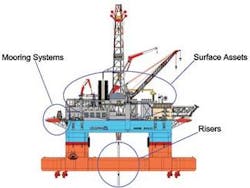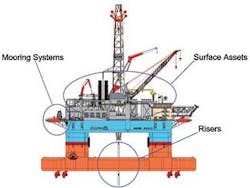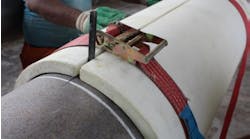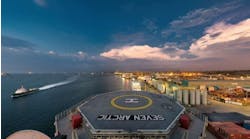Designing an improving asset management system for offshore drilling operations
M.R. Riddell - NOV M/D Totco
Effective management of drilling assets in the offshore environment is a critical operational function with enormous cost implications globally. Offshore rigs, particularly floaters, have many more assets than a typical land or onshore drilling operation, including highly valuable subsea assets. While normally attached or assigned to the rig for long periods, offshore assets still move from rig to rig and from rig to dock in support of routine maintenance and inspection programs, and in support of changing operational needs.
Typically, back-up or reserve assets are sent to yards where they are maintained until needed by rigs drilling in the local area. However, these reserve assets need to be “visible” to operations managers and maintained in “ready to run” condition until needed to perform with very high reliability since rig time is so costly. This requirement highlights the need for an effective, flexible preventative maintenance program. Maintenance programs play a key role in the success of drilling operations and in the contractor’s ability to meet the performance expectations of operators.
When maintenance is performed, key data elements must be collected, analyzed, and turned into procedural improvements that minimize downtime. Goals of a successful offshore asset management program include:
- Permanent asset identification
- Reliable software running at the rig for managing asset transfers and maintenance programs
- Internet connectivity for data uploads and downloads
- Web application, so asset data is available globally
- A single managed and secure central database
- Well-planned training, implementation, and support services
- Analytical reporting services.
Overcoming common asset management problems
Proper planning and design of the asset management program is one of the largest success factors in overcoming common problems. In the offshore environment, the location and status of all assets is necessary for making operational decisions involving asset utilization.
Without an adequately designed asset management framework, four common pitfalls may lead to an unsuccessful program result:
- Assets are not tagged properly: An ineffective or incomplete asset ID system leads to some assets becoming lost or, when the ID is a generic naming convention such as “Mud Pump No. 1,” the asset description may not be physically tied to a specific piece of equipment (serial number). Therefore, it becomes impossible to know which pump this is, or its correct history, documentation and “ready to run” status. Tagging subsea assets requires specially designed tags and tag mounts that accommodate high pressures and long-term exposure to sea water.
- Asset movements are not consistently tracked: Without a system for capturing every asset movement between cost centers or locations, assets are loaded onto a work boat for transport and asset visibility may be lost. The end result may be unrecorded asset movements that quickly disable logistics decision making and may result in substantial man-hours spent finding a particular asset. If this process continues for an extended time, there is no certainty regarding the location of any assets other than those immediately identifiable on the rig or in the yard. In response, it may be necessary to rent or purchase replacements for assets that cannot be located in a timely manner.
- Maintenance results are not captured or analyzed: In addition to basic tracking of planned and unplanned maintenance events, certain types of data from events, when captured in a way that feeds planned analysis tools, generates interpretable results that support maintenance decision making.
Examples of collected data used to fuel a maintenance analysis are completed and incomplete maintenance work orders, replacement parts used by make/model, performance results for each user performing maintenance, equipment meter and condition readings, and unplanned work orders opened by equipment make/model. Properly-designed analysis leads to improved maintenance procedures, improved training programs for maintenance personnel, optimized purchasing decisions for parts and other components, and a reduction in unplanned work orders. - Documentation cannot be accessed: Assets typically have a history of documentation including purchase and warranty documents, repair and inspection documents, and a variety of other relevant documentation. These documents are necessary for making informed decisions about repairs needed and who is responsible for repair costs, scheduling maintenance and inspections, determining if an asset is ready to run, and ultimately the asset’s status in terms of its useful life.
For complex mechanical assets or subsea assets, these documents over the life of the asset can occupy an entire file drawer. The problem is that hard copy documentation is never available at the time or place where it’s needed.
Planning for a successful implementation
There should be an organized requirements gathering and planning process before any system is chosen and implemented. Whether the system is relatively expensive or inexpensive, it must be readily adopted by the organization so that:
1. All assets are permanently ID’d, tracked, and are “visible” at all times
2. Field and office personnel are trained in an orderly fashion and have access to retraining
3. Maintenance procedures are designed to gather key data and enable the rapid deployment of changes to procedures as dictated by data analysis
4. Relevant asset documentation for operational decision making is always attached to each asset regardless of its location.
The bottom line is that the system must perform. For example, an investment in an asset management system that captures 80% of the current asset location and status information, or 70% of the maintenance results becomes an albatross around an organization’s neck. Decision makers cannot rely on partial or inaccurate data and eventually their use of the system will decline.
These goals should be addressed in requirements that incorporate details about specific operational needs including:
- The global distribution of rigs and yards
- The structure of the system user base including organizational structure and workflows
- Specific current asset management problems that need to be addressed; expected timeframes for implementation
- Agreed-upon metrics for measuring success.
Once the requirements are established and the best system solution is chosen, the implementation planning process can begin. Effective implementation planning does not have to be a time-consuming process. If a standardized implementation framework and process is available, filling in the blanks with tasks and timeframes can be expedited. Before any equipment or software is deployed, the implementation plan should be approved by all key decision makers.
As with any project of critical importance, the quality of the planning has a direct impact on the project’s success. That said, the plan has to be flexible and able to address changing conditions and events that may not have been anticipated. In most cases, either the timing or order of events, logistics, responsibility for certain tasks, numbers of people to be trained or equipment required in the field, will all change before the project is completed. The end result should remain the same and the implementation does not end when all the equipment is deployed, the software is configured, and all the training is done.
A properly designed implementation includes a post-deployment phase where system performance is closely monitored. This process will identify users who are not using the system as intended; assets that are not properly tagged or described; or transfers or maintenance work orders that are not being completed.
This information should immediately be turned into action items. Once the intensive post-deployment monitoring shows acceptable results, the system monitoring should be turned over to routine long-term monitoring.
New offshore technologies
Managing subsea assets has been a unique challenge due to the relative cost of these assets and their long-term exposure to harsh environments. The performance requirements for subsea assets are extreme with essentially zero failure tolerance for many components. The fundamental issue underlying an effective subsea management system is the necessity for a reliable way to permanently identify each asset. For some components, conventional metal tags or engraved numbers tags become unreadable or lost sometimes requiring extra time or methods to verify the asset ID. Approaches such as welding simple asset ID numbers on the asset, are typically ad hoc yet workable as long as the asset stays on the rig. However, once the asset leaves for another rig or the yard, the system can break down.
Therefore, how do personnel permanently identify assets with tags that are durable and fit for the asset’s working environment? The solution is a set of sub-solutions each designed for the type of asset or asset component involved. Here’s a breakdown of asset classes and subclasses that each require a unique asset tagging solution:
- 1. Marine risers
- 2. Mooring components
- a. Wires
- b. Chains
- c. Anchors
- 3. BOP components
- 4. Rig equipment
- 5. Other vessel assets
The basic tagging technologies used to accomplish these solutions are combinations of radio frequency identification (RFID) and bar code tags. Subsea tags have to be designed for impact resistance, hydrostatic pressure, and exposure to corrosive fluids (sea water). Surface tags are designed to accommodate the type of equipment and whether the equipment is indoors or outdoors and subjected to such conditions as the environment, pressure washing, or painting. To accomplish the 100% solution outlined in the system requirements for an effective asset management system, a permanent tagging solution for all of these asset types should be incorporated into the implementation plan.
The goal: continuous improvement
An effective asset management program has to deliver measurable results with respect to two company-wide goals:
1. Continuously improving rig reliability and performance
2. Maximizing the return on the company’s asset investment.
Continuous improvement is defined as a program put in place to capture and analyze key asset and asset performance data. Decisions can be made continuously to improve asset maintenance and utilization leading to optimized rig performance and asset investment strategies. The system is driven by a continuous feedback loop starting with raw data acquisition at the user level, to specialized data analysis techniques, to operational decision making based on the analysis, and to revised and updated procedures for maintenance, utilization, and purchasing. Results of enhanced procedures are measured, starting with the data acquisition step at the beginning of the loop.
Some evolved examples of this feedback loop are Reliability Centered Maintenance (RCM) and predictive maintenance programs which are the latest proactive approaches in the drilling market for continuous improvement related to equipment maintenance. The continuous improvement goal remains the same – acquire data, conduct data analysis, and make decisions that proactively prevent equipment failures. The data can be collected manually with using a handheld device, or obtained directly from sensors on the equipment. Once a program of this type is implemented, data analysis produces trends revealing common failure modes which allow decision making on how to mitigate failure risks.
A continuous improvement platform is also the basis for organizational goal-setting. Once an asset management system-based performance benchmark is set, management can use the system to periodically establish new benchmarks and measure results. With the proper system, this goal-setting can be done at any organizational level starting with the individual employee incorporating actual performance data and training objectives for improving performance.
Rigs or regions can be benchmarked against each other or against the company as a whole, to drive awareness of actual performance relative to performance goals. Finally, using predetermined metrics for this purpose, performance results versus internal or external benchmarks can be used to market the drilling contractor’s performance improvement efforts to operators.
About the author
Since 1978, M.R. (Mark) Riddell has been an engineer and manager of upstream technology-based field services. Riddell has specialized in data acquisition and analysis for exploration well testing and production system engineering, both on land and in deepwater. He has been an independent consultant and has worked in field engineering, management, and sales for Schlumberger, Wood Group and (now) NOV M/D Totco as manager of the RigMS asset management product line.
Riddell holds a B.S. degree from The College of William and Mary, with graduate work at various universities. For more information, contact:[email protected]






